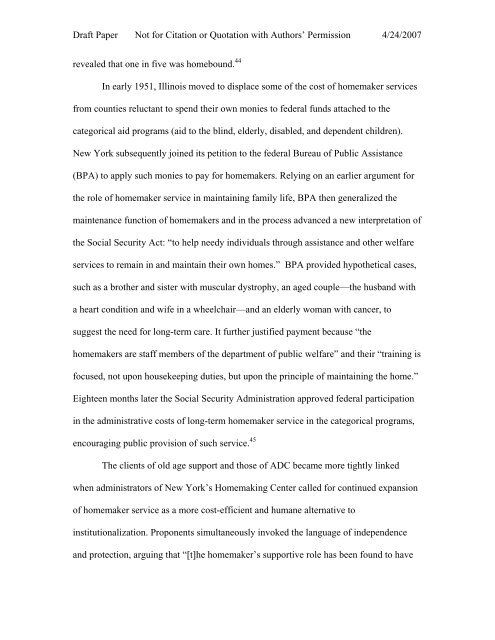Organizing Home Care: - School of Social Service Administration
Organizing Home Care: - School of Social Service Administration
Organizing Home Care: - School of Social Service Administration
Create successful ePaper yourself
Turn your PDF publications into a flip-book with our unique Google optimized e-Paper software.
Draft Paper Not for Citation or Quotation with Authors’ Permission 4/24/2007<br />
revealed that one in five was homebound. 44<br />
In early 1951, Illinois moved to displace some <strong>of</strong> the cost <strong>of</strong> homemaker services<br />
from counties reluctant to spend their own monies to federal funds attached to the<br />
categorical aid programs (aid to the blind, elderly, disabled, and dependent children).<br />
New York subsequently joined its petition to the federal Bureau <strong>of</strong> Public Assistance<br />
(BPA) to apply such monies to pay for homemakers. Relying on an earlier argument for<br />
the role <strong>of</strong> homemaker service in maintaining family life, BPA then generalized the<br />
maintenance function <strong>of</strong> homemakers and in the process advanced a new interpretation <strong>of</strong><br />
the <strong>Social</strong> Security Act: “to help needy individuals through assistance and other welfare<br />
services to remain in and maintain their own homes.” BPA provided hypothetical cases,<br />
such as a brother and sister with muscular dystrophy, an aged couple—the husband with<br />
a heart condition and wife in a wheelchair—and an elderly woman with cancer, to<br />
suggest the need for long-term care. It further justified payment because “the<br />
homemakers are staff members <strong>of</strong> the department <strong>of</strong> public welfare” and their “training is<br />
focused, not upon housekeeping duties, but upon the principle <strong>of</strong> maintaining the home.”<br />
Eighteen months later the <strong>Social</strong> Security <strong>Administration</strong> approved federal participation<br />
in the administrative costs <strong>of</strong> long-term homemaker service in the categorical programs,<br />
encouraging public provision <strong>of</strong> such service. 45<br />
The clients <strong>of</strong> old age support and those <strong>of</strong> ADC became more tightly linked<br />
when administrators <strong>of</strong> New York’s <strong>Home</strong>making Center called for continued expansion<br />
<strong>of</strong> homemaker service as a more cost-efficient and humane alternative to<br />
institutionalization. Proponents simultaneously invoked the language <strong>of</strong> independence<br />
and protection, arguing that “[t]he homemaker’s supportive role has been found to have
















